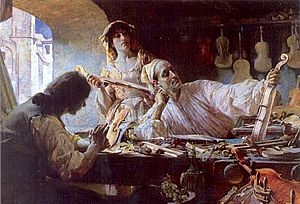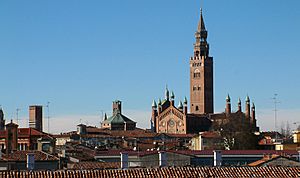Antonio Stradivari facts for kids
Quick facts for kids
Antonio Stradivari
|
|
|---|---|
 |
|
| Born |
Antonius Stradivarius
c. 1644 |
| Died | 18 December 1737 (aged 92–93) Cremona, Lombardy
|
| Resting place | Church of San Domenico |
| Education |
|
| Known for | Luthier |
|
Notable work
|
|
| Style |
|
| Movement | Cremonese school |
| Spouse(s) |
Francesca Ferraboschi
(m. 1667; died 1698)Antonia Maria Zambelli
(m. 1699) |
| Memorial(s) | 19189 Stradivari (Asteroid) |
Antonio Stradivari (born around 1644 – died December 18, 1737) was a famous Italian luthier. A luthier is a skilled craftsman who makes or repairs string instruments. Stradivari made many instruments like violins, cellos, guitars, violas, and harps.
The Latin form of his name, Stradivarius, is often used for his instruments. People also call them "Strads." It is thought that Stradivari made 1,116 instruments in his lifetime. About 960 of these were violins. Today, around 650 of his instruments still exist. This includes about 450 to 512 violins. His instruments are known as some of the best ever made. They are very valuable and sought after by collectors.
Contents
Biography
Early Life and Training
Antonio Stradivari was likely born in Cremona, Italy, around 1644. His family had lived in Cremona for a long time. They were well-known citizens. The name "Stradivari" might mean "toll-man" or "open road."
Antonio's parents were Alessandro Stradivari and Anna Moroni. They married in 1622. There are no records of Antonio's early childhood. The first proof of him in Cremona is from a label on one of his violins made in 1666.
Stradivari probably started learning his craft between the ages of 12 and 14. He might have been an apprentice to Nicola Amati. Amati was a famous violin maker in Cremona. A label on Stradivari's 1666 violin says, "Student of Nicolai Amati." However, Stradivari's early violins did not look exactly like Amati's.
Some experts think Stradivari might have learned from Francesco Rugeri instead. Rugeri was another violin maker. Stradivari's early instruments look more like Rugeri's work. Also, Amati and his students used a special pin when making instruments. Stradivari did not use this pin. Neither did the Rugeri family. This suggests he might have learned from Rugeri, even though both were influenced by Amati.
Another idea is that Stradivari started as a woodworker. He might have decorated Amati's instruments. This could explain the fancy decorations on some of his later violins. If he was Amati's student, he would have started around 1656-1658. He likely stayed in Amati's workshop until about 1684. This helped him start his own career.
Family Life
Stradivari married his first wife, Francesca Ferraboschi, on July 4, 1667. Francesca was a widow with two children. They had a daughter, Giulia Maria, a few months later. They had five more children: Francesco, Catterina, Alessandro, and Omobono Stradivari. One infant son lived only a week.
Around 1680, Stradivari bought a house at No. 1 Piazza Roma. This house was near other famous violin-making families, like the Amatis and Guarneris. He probably worked in the attic of this house. He lived there for the rest of his life. Francesca died on May 20, 1698.
Stradivari married his second wife, Antonia Maria Zambelli, on August 24, 1699. She was 35 years old. They had five children between 1700 and 1708.
Later Years and Legacy
Antonio Stradivari died in Cremona on December 18, 1737. He was 93 years old. He had been making instruments for about 75 years. He was buried in the Church of San Domenico.
Stradivari became very wealthy during his life. In his will, he left money and property to his eight living children and his wife. His sons, Francesco and Omobono, had worked in his shop. Omobono inherited six violins. Francesco, who was meant to take over his father's business, inherited the rest. This included all the tools, patterns, and finished violins.
Career
Developing His Style
Stradivari slowly developed his own unique style. Some of his early violins were smaller. An exception is the 1679 Hellier violin, which was much larger. His early violins (before 1684) were stronger and had less rounded curves than Amati's.
By 1680, Stradivari was becoming well-known. In 1682, a banker from Venice ordered a full set of instruments from him. In 1684, Amati died. After this, Stradivari started making more instruments. His style also changed. His instruments became larger, more like Amati's work from earlier years. He also started making more distinct edges and outlining the instrument heads in black.
Stradivari experimented a lot in his early career. His instruments from this time are sometimes seen as less perfect than his later ones. However, his precise carving and inlay work quickly showed he was a very skilled craftsman. A great example is the 1690 "Tuscan" violin.
"Golden" Period
In the early 1690s, Stradivari changed his instrument-making style. He started making violins with a larger shape. These are known as "Long Strads." He also began using a darker, richer varnish. He used this style until 1698. After that, he went back to a slightly shorter model.
The years from 1700 to 1725 are called his "Golden Period." Instruments made during this time are considered his best. They are known for their high quality. Instruments made later, from the late 1720s until his death, show signs of his old age. They might not be as beautiful, but many still have a wonderful sound.
Stradivari and the Cremonese Violin Making School
His Influence
Stradivari and the Amati family were at the heart of violin making in Cremona. They influenced each other and other makers. Their work set the standards for violin making for the next 300 years.
Even in the early 1700s, Stradivari's influence was clear. Makers in other countries, like Barak Norman in Britain, copied his style. Daniel Parker, another British luthier, made excellent violins based on Stradivari's "long pattern." Later, in the 1800s, Jean-Baptiste Vuillaume in France made many copies of Strads.
After Stradivari died, his instruments became very popular with collectors. Many local musicians could no longer afford them. This is when the "Stradivari fever" began. People like Count Ignazio Alessandro Cozio di Salabue and Vuillaume helped make these instruments incredibly famous and valuable. Other major violin makers in Cremona also died soon after Stradivari. This ended the "golden period" of violin making in Cremona.
Many other luthiers were influenced by Stradivari. Vincenzo Rugeri adopted a lower arch for his instruments, like Stradivari. The Gagliano family made copies of Stradivari's instruments. Giovanni Battista Guadagnini also made replicas. Vincenzo Panormo and José Contreras in Spain also based many of their violins on Strads.
Stradivari and His Sons
Antonio Stradivari worked for a very long time. But it's impossible for him to have made over 1,000 instruments all by himself. This means his sons, Francesco and Omobono, must have helped in his workshop.
Omobono made a few instruments on his own after leaving the workshop. Francesco spent most of his life working with his father. He made very few violins independently. This is why Francesco inherited more from his father than Omobono. One big difference in their work was the quality of the purfling (the decorative edge) on their instruments. Francesco and Omobono's purfling was not as good as their father's.
Stradivarius Instruments

Experts believe Stradivari made 1,116 instruments. About 960 of these were violins. Around 650 of these instruments still exist today. This includes about 450 to 512 violins.
Stradivari's instruments are considered among the best ever made. They are highly valued and are still played by professional musicians. Many violinists prefer them over instruments by other makers, except for Giuseppe Guarneri del Gesù. However, some tests have shown that people cannot always tell the difference between a Stradivarius and other high-quality instruments just by listening.
The labels on Stradivarius instruments usually have a Latin inscription. After 1890, copies also had the country of origin. Many instruments are based on Stradivari's designs and have his name. This can sometimes trick people into buying fake Stradivarius instruments. It's important to have instruments checked by experts to make sure they are real.
Many famous musicians play Stradivari instruments. For example, Yo-Yo Ma uses the Davidov Stradivarius cello. Itzhak Perlman owns the Soil violin. The Vienna Philharmonic orchestra uses several Stradivari instruments. The Messiah Stradivarius violin is on display at the Ashmolean Museum in Oxford, England. It is not played to help preserve it.
Stradivarius instruments have sold for very high prices at auctions. In 2005, the Lady Tennant sold for over $2 million. In 2006, the Hammer sold for over $3.5 million. In 2011, the Lady Blunt Stradivarius sold for almost £10 million. This money went to help victims of the 2011 Tōhoku earthquake and tsunami in Japan.
You can see collections of Stradivari instruments in several places:
- The Library of Congress has three violins, a viola, and a cello.
- The Spanish royal collection has five instruments at the Royal Palace of Madrid.
- London's Royal Academy of Music has several Stradivari instruments.
- The Musée de la musique in Paris also displays several beautiful Stradivari instruments.
- The Metropolitan Museum of Art has three Stradivari violins.
- The National Music Museum has one of two known Stradivari guitars and other rare instruments.
See also
 In Spanish: Antonio Stradivari para niños
In Spanish: Antonio Stradivari para niños


